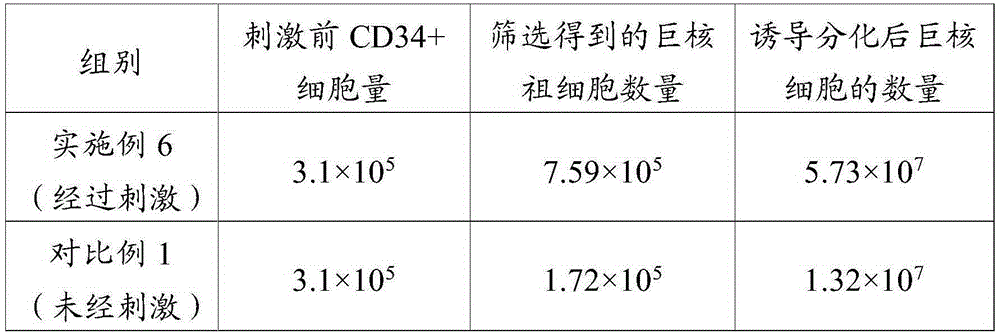Separation method for megakaryocyte progenitors
A separation method and technology of nuclear cells, applied in animal cells, vertebrate cells, blood/immune system cells, etc., can solve the problems of low megakaryocyte ratio and low yield
- Summary
- Abstract
- Description
- Claims
- Application Information
AI Technical Summary
Problems solved by technology
Method used
Image
Examples
Embodiment 1
[0038] Example 1 Mononuclear cell isolation
[0039] Add 25 mL of hydroxyethyl starch injection (Beijing Shuanghe Pharmaceutical Co., Ltd.) (cord blood: hydroxyethyl starch = 2:1 (v / v)) to 50 mL of the collected cord blood, mix well, and stand still for 15 minutes Above, sediment erythrocytes, and aspirate the supernatant;
[0040] The supernatant was added to a centrifuge tube containing lymphocyte separation solution (supernatant:separation solution=2:1 (v / v)), centrifuged at 3000 rpm for 20 min, and mononuclear cells were collected.
[0041] The collected mononuclear cells were washed with PBS and centrifuged at 1500 rpm for 10 min, repeated twice. After cell counting, the number of mononuclear cells was 5.82×10 7 , of which the number of CD34+ cells is 3.05×10 5 indivual.
Embodiment 2
[0042] Example 2 Mononuclear cell isolation
[0043] Add 12.5 mL of hydroxyethyl starch injection (Beijing Shuanghe Pharmaceutical Co., Ltd.) (cord blood: hydroxyethyl starch = 4:1 (v / v)) to 50 mL of collected umbilical cord blood, mix well, stand still More than 15min, sediment erythrocytes, suck the supernatant;
[0044] The supernatant was added to a centrifuge tube containing lymphocyte separation solution (supernatant:separation solution=2:1 (v / v)), centrifuged at 3000 rpm for 20 min, and mononuclear cells were collected.
[0045] The collected mononuclear cells were washed with PBS and centrifuged at 1500 rpm for 10 min, repeated twice. After cell counting, the number of mononuclear cells was 6.15×10 7 of which the number of CD34+ cells is 3.18×10 5 indivual.
Embodiment 3
[0046] Example 3 Mononuclear cell isolation
[0047] Add 8.3 mL of hydroxyethyl starch injection (Beijing Shuanghe Pharmaceutical Co., Ltd.) (cord blood: hydroxyethyl starch = 6:1 (v / v)) to 50 mL of the collected cord blood, mix well, and stand still. More than 15min, sediment erythrocytes, suck the supernatant;
[0048] The supernatant was added to a centrifuge tube containing lymphocyte separation solution (supernatant:separation solution=2:1 (v / v)), centrifuged at 3000 rpm for 20 min, and mononuclear cells were collected.
[0049] The collected mononuclear cells were washed with PBS and centrifuged at 1500 rpm for 10 min, repeated twice. After cell counting, the number of mononuclear cells was 6.04×10 7 of which the number of CD34+ cells is 3.10×10 5 indivual.
PUM
 Login to View More
Login to View More Abstract
Description
Claims
Application Information
 Login to View More
Login to View More - R&D
- Intellectual Property
- Life Sciences
- Materials
- Tech Scout
- Unparalleled Data Quality
- Higher Quality Content
- 60% Fewer Hallucinations
Browse by: Latest US Patents, China's latest patents, Technical Efficacy Thesaurus, Application Domain, Technology Topic, Popular Technical Reports.
© 2025 PatSnap. All rights reserved.Legal|Privacy policy|Modern Slavery Act Transparency Statement|Sitemap|About US| Contact US: help@patsnap.com

